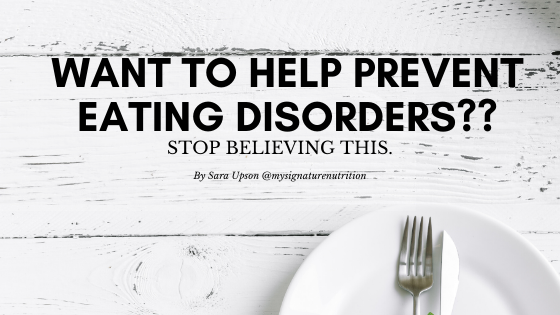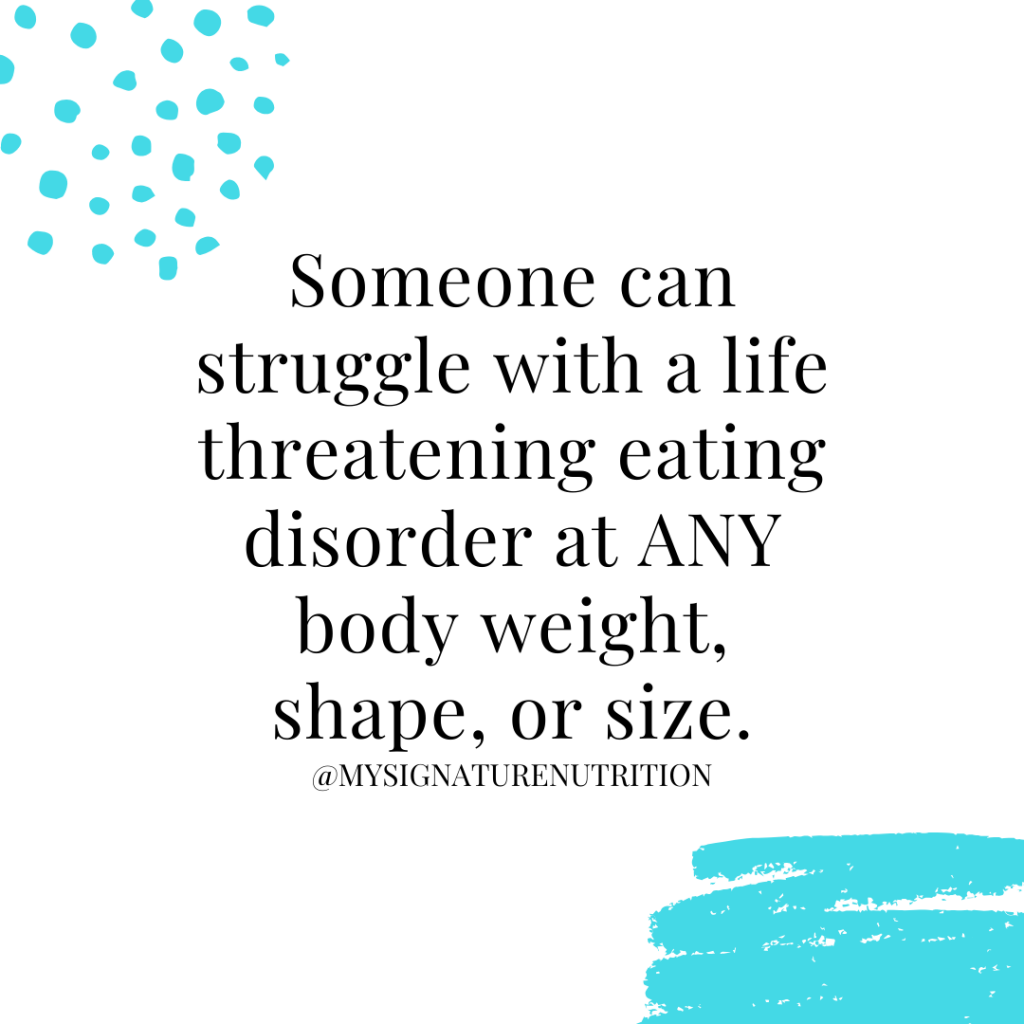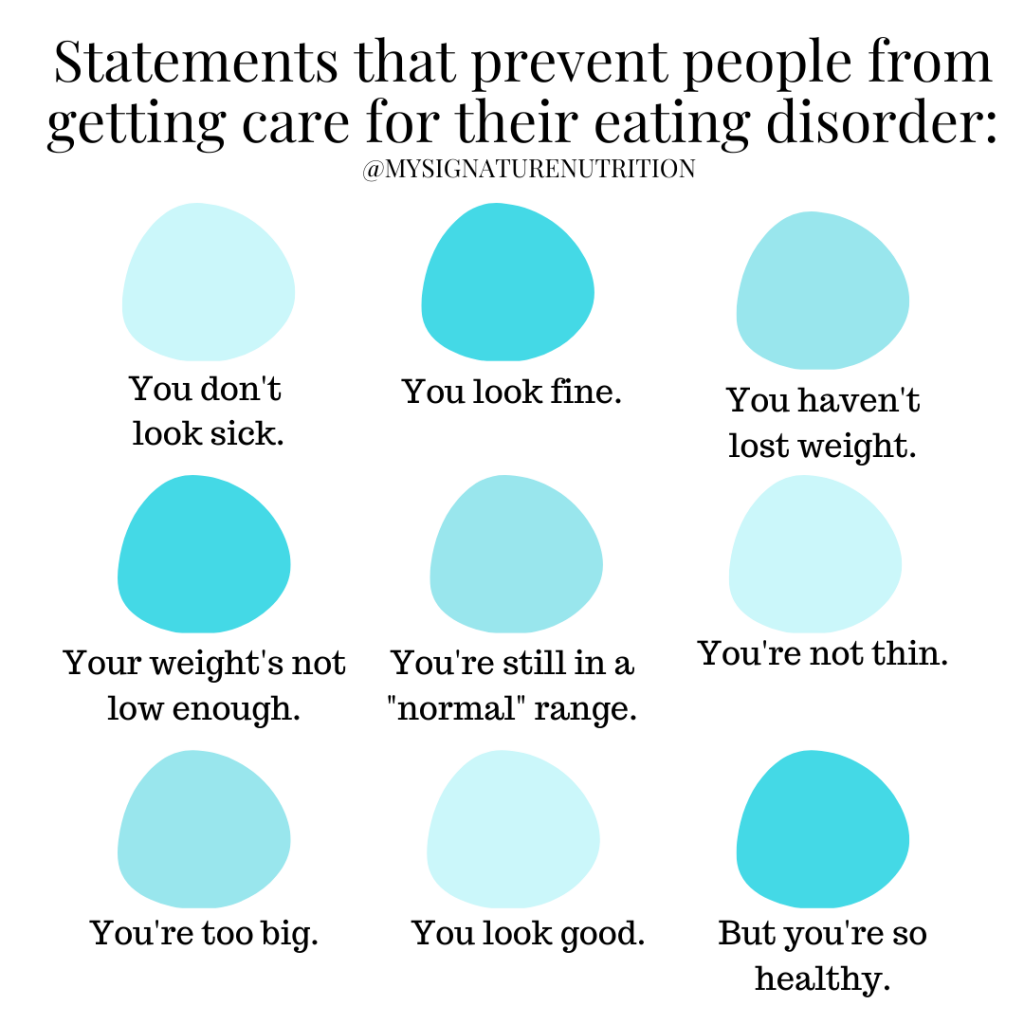Want to help prevent eating disorders? Stop believing this.
February 17th, 2020 by Sara Upson

“You don’t look sick…
“You look fine…
“You haven’t lost weight….
“Your weight’s not low enough…
…you don’t have an eating disorder.”
All some of the most harmful comments that you can tell someone struggling with their eating. The truth is- weight cannot tell you whether or not someone has an eating disorder. Weight cannot tell you if someone’s eating disorder is “serious.” You cannot tell if someone has an eating disorder just by looking. So if you want to help prevent eating disorders- stop believing that it’s all about weight. Here’s the truth:

1. Anyone of any body shape or size can have an eating disorder– and you can’t tell who- just by looking, based on weight, or clothing size. The reality is anyone can have an eating disorder and eating disorders occur across the weight spectrum. To say it differently, anyone of any size can struggle with any type eating disorder or eating disorder diagnosis.
This might be hard to believe because the media sensationalizes what an eating disorder looks like. If we relied on the media for education about eating disorders, you’d only see one type of body that has an eating disorder. (Oh wait, that is what you see!) The truth is- any body of any shape or size can have an eating disorder, and you’re only shown one very stereotypical body of what an eating disorder looks like. Most people with an eating disorder won’t look like that. According to research, most people with an eating disorder will not be underweight, and a 2018 study found that 31% of individuals with anorexia were not underweight. (Whitelaw, 2018)

The truth is, eating disorders don’t have a “look.” Believing that you can tell if someone is sick prevents people from getting help they need.
2. Body size doesn’t tell you what kind of eating disorder someone struggles with. Again when we turn to media for education about eating disorders, what you’ll typically see is sensationalized images and stories that are the extreme. These stories aren’t helpful because most people who have an eating disorder- won’t identify with the story. Instead of thinking, that’s me, people end up thinking, “I’m fine, it’s not that bad, I’m not underweight, so I’m okay. Or I binge eat, but I’m not at higher weight so I’m fine.” Even worse- doctors, health care providers, family and friends typically reinforce these same messages. It doesn’t help people from getting care- it prevents them from getting care.

In reality- anyone of any size can struggle with any eating disorder. That means someone in a “normal weight” (per diet culture) to “higher weight” (again, per diet culture) body could have anorexia, bulimia, binge eating disorder, eating disorder not otherwise specified. AND, someone with a straight size body, per diet culture, could have binge eating disorder, bulimia, anorexia, or an eating disorder not otherwise specified.
Eating disorders don’t have a shape or size and the belief that you can tell is harmful. Again, it prevents people from getting care.
3. Weight does not depict severity. All eating disorders are serious and worthy of help, but so often we only hear about or see people who were extremely underweight. This sensationalized version of eating disorders is harmful. Weight cannot tell you who’s most severe or struggling with their eating disorder. Medical consequences can happen at any body shape or size, and size alone doesn’t depict severity.
Weight can’t tell you who is struggling the most. A 2019 study looking at atypical anorexia and health consequences found that people with the most dramatic weight loss were the most ill- regardless of the starting weight. (Garber, 2019) It’s so easy for diet culture to focus on the lowest weight person as the most ill, but the reality is- weight isn’t an indicator for illness. A 2016 study found that “distress related to eating and body image was more severe for people with anorexia” at a normal to higher weight status. (Sawyer, 2016)

Focusing on weight is downright harmful. Weight does not communicate who has an eating disorder, type of eating disorder, or severity of eating disorder. The reality is, an eating disorder behavior is an eating disorder behavior regardless of body weight, shape or size.
The belief that only certain bodies struggle with an eating disorder prevents people from getting help, shames those who struggle and says that they’re not sick when they are. Someone could have a life threatening eating disorder and not seek treatment because- they think their weight isn’t low enough, their family and friends say it’s fine, their doctor celebrates their weight loss, other people praise them for getting in to shape and having self control… The reality is you can never know who has an eating disorder or who doesn’t. You can’t tell just by looking.

So if you care about helping prevent eating disorders- then stop believing that it’s all about weight. Don’t compliment weight loss or applaud someone about their eating. You may end up reinforcing the eating disorder rather than helping them find help
So what can you do?

- Focus on behaviors, emotions, thought patterns. (images)
- Never be dismissive if someone expresses concern about their body or their eating.
- Never compliment or celebrate weight loss.
- Don’t make weight based comments inferring that certain weights are better or worse.
- If you’re concerned about someone, ask if they’re okay. Express your worries.
- If you know someone who’s lost weight- instead of complimenting them, ask if they’re okay. Do not compliment weight.
- Reach out for support. You don’t have to have all the answers. A professional trained in the treatment of eating disorders can support you.
References:
Whitelaw M Lee KJ Gilbertson H, Sawyer SM. Predictors of Complications in Anorexia Nervosa and Atypical Anorexia Nervosa: Degree of Underweight or Extent and Recency of Weight Loss? Adolesc Health. 2018 Dec;63(6):717-723. doi: 10.1016/j.jadohealth.2018.08.019.
Andrea K. Garber, Jing Cheng, Erin C. Accurso, Sally H. Adams, Sara M. Buckelew, Cynthia J. Kapphahn, Anna Kreiter, Daniel Le Grange, Vanessa I. Machen, Anna-Barbara Moscicki, Kristina Saffran, Allyson F. Sy, Leslie Wilson, Neville H. Golden. Weight Loss and Illness Severity in Adolescents With Atypical Anorexia Nervosa. Pediatrics Dec 2019, 144 (6) e20192339; DOI: 10.1542/peds.2019-2339
Susan M. Sawyer, Melissa Whitelaw, Daniel Le Grange, Michele Yeo, Elizabeth K. Hughes. Physical and Psychological Morbidity in Adolescents With Atypical Anorexia Nervosa. Pediatrics Apr 2016, 137 (4) e20154080; DOI: 10.1542/peds.2015-4080
Comments are closed.





